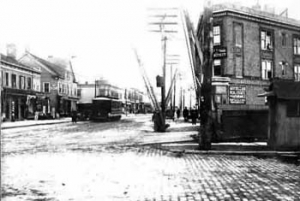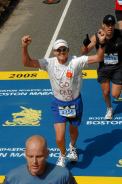Dear Donald,
different locations: Australia, the United Kingdom, and
the United States.
Our genealogy research continues to expand also as
we get new subscribers (up to 48 now) who wish to
share their own research. This brings us to Sandra
Walcyk’s story below. Her ancestors settled in
western New York state in the early 1820s.
Enjoy.
| Plank Roads |
Ray Jerrems, Our Genealogist, Historian
Why talk about plank roads?

No, I have not taken leave of my senses. Plank roads
did actually exist
Sandra Walcyk, one of our subscribers, has
unearthed a fascinating piece of US history in her
research on her branch of the
Jerrems family. It is the construction of plank
roads,
and it also involves her great great grandfather
(Joseph) and his brother Joseph, both of
whom
migrated to the US and
settled in Utica in New York State.
Sandra has an additional interest in the history of the
Utica area because she grew up there. There is a
weekend festival there in the summer each year
called “Plank Road
Days”.
The origins of plank roads. Plank roads were
used in a number of countries, including Russia,
China, Canada, the US and (to a much lesser extent)
Australia.
They were first built in the US in the 1820s. Heavy
timbers were laid crossways on top of the ground like
railway sleepers/ties, and were of similar thickness.
For the sake of simplicity I will call them
“sleepers”.
Although some of the roads may have only had
sleepers, these by themselves would have given a
rough ride. Other roads had two sets of additional
planks running lengthways along the road, fixed on
top of the sleepers for the vehicle wheels to run
along. Some photos also show a more elaborate
system also using additional planks running
lengthways, but fixed along the ends of the sleepers to
stop movement of the sleepers and to provide an
outer guide rail for vehicle wheels.
It seems to me that the addition of planks for the
wheels running lengthways was the best method of
construction because the longitudinal planks
stabilised the sleepers, took the brunt of the wear and
tear and could be replaced fairly easily One feature of
the plank roads is that they were at least 8 foot wide
(some were a lot wider) with wider parts at intervals
for vehicles to pull into, to allow oncoming vehicles to
pass. These wider sections were called “turnouts”.
The advantages of plank roads. Looking at
photos on the internet I would say that the plank roads
were mainly suitable for light to medium size vehicles.
They would have been ideal to provide a fast trip for
people
commuting between towns and for light commercial
vehicles. Plank roads therefore gave a safer, faster,
and more comfortable ride for vehicles. Perhaps
surprisingly they cost a lot less to construct than
normal well-constructed roads, possibly because
labour was cheap in those days and before the days
of massive land clearing a lot of local timber would
have been available for use. Also they
could be built over sand hills (a feat well beyond the
capabilities of normal road construction) and over
rocky or boggy ground.
It was soon discovered that the economic advantage
of the low initial cost of construction was offset by high
maintenance costs. The iron shod narrow wheels of
the horse-drawn vehicles would have cut into the
timber (I have seen places where wagon wheels even
cut grooves in stone) and the horses’ shoes would
have chopped the timber. Probably the ballasting (if
any) under the sleepers would also have been
dislodged over a period of time, leading to breakage
of the planks on top. In the US the roads were often
built by turnpike companies, so that people using
these roads paid tolls to the road owners.
But it was not all a bed of roses for the public
and the road owners. Some of the articles about the
Utica
road that Sandra has found showed public
dissatisfaction with the toll gates and bridges. It is
possible also that people resented the fact
that the plank companies had monopolies and could
charge what they liked (sounds familiar doesn’t it?).
Plank roads also proved to be of military use in the
American Civil War.
Although plank roads were built in Australia the only
systematic use of plank roads was in outer parts of
Perth in Western Australia in the early1900s. This
explains why I had never heard of them before. In
Western Australia the planks were made
of very tough jarrah timber, which would have lasted a
lot longer than the softer Northern Hemisphere
timbers. A somewhat similar (but far more
rudimentary) technique was used on Australian bush
roads, which were often “corduroyed”
through boggy areas with cut saplings and logs laid
crossways.
Very little evidence of the plank roads still exists. When
plank roads were abandoned they were quickly pulled
to pieces for their timber, so we have to rely mostly on
old photos to see how and where they were built.
Plank roads and the Jerrems family. A plank
road was built by the Bridgewater & Utica
Plank Road Company in the 1840s between Utica and
Bridgewater, a distance of 18 miles. It had a generous
width of 12 feet. Perhaps this generosity was too
much for the Company’s finances because it
went broke and sold the road in 1859.
The route of the road was, and still is, Oneida Street.
Sandra’s great great grandfather Joseph and his
family lived in Utica, and his brother James and
his family lived seven miles south at Washington
Mills. When it was first built the plank road, which went
past Washington Mills, would have given
Joseph, his wife Sarah and their 2 family a much
easier trip to visit James and his extensive family.
Similarly James and his family would have had a
much better trip to Utica to go to the markets and visit
Joseph and his family.
James had an additional interest in using the road. At
Washington Mills he made soap, which he would
have transported to factories and stores in Utica. On
some return trips he would have brought back the raw
materials required for making soap.
The plank road would also have given him easier
access to the villages further out towards Bridgewater.
The end of the road. So I have not taken leave of my
senses.
| Running Warren in the Boston Marathon |
Brother Donald who was a Spectator
A Memorable Boston Weekend in mid-April!

time of 3:34; he ran the last 25 miles with an injured
heel. His qualifiying time was 3:10, so the injury took
its toll on his time, but not his spirits (see nearby
picture).
The weekend was eventful. The brothers Jerrems
watched the exciting U.S. Women’s Olympic Marathon
Trials on Sunday (a separate race from the traditional
Boston race)
They attended a Red Sox games at Fenway Park
(pictured). The
Sox came back from a 5-0 deficit to beat the Texas
Rangers.
| Proud Parents and Grand Parents |
Anita and Brad, Ray and Di
New Subscriber
Welcoming newborn Samantha to Anita and
Brad’s household.
Pictured: Ray and Di’s granddaughters Jessica
(the
older one, DOB July 29 2005) and Samantha
(three and a half weeks).


